PRINCETON, NJ -- ║┌┴¤═°'s "Net New Hiring Activity" measure fell 1.1 percentage points from March to April, followed by a 3.6-point decline between April and the week of May 12-18 -- continuing the trend of steady declines since the beginning of the year.
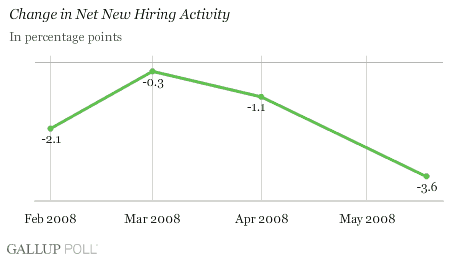
Job Growth Declining in April and Early May
Economic activity may be slowing more significantly than generally expected, based on ║┌┴¤═°'s Net New Hiring Activity measures for April and May, with both months showing substantial declines. ║┌┴¤═°'s Net New Hiring Activity measure is an effort to assess U.S. job creation or elimination based on a survey of more than 8,000 individual workers each month. In order to calculate this measure, ║┌┴¤═° asks current full-time employees whether their employers are hiring new people and expanding the size of their workforces, not changing the size of their workforces, or letting people go and reducing the size of their workforces. Net new hiring activity is computed by subtracting the "letting go and reducing" percentage from the "hiring and expanding" percentage.
Over the first four months of this year, the percentage of employees saying their companies are hiring has fallen from 39.8% in January to 38.1% in April. At the same time, the percentage of employees reporting that their firms are letting people go has increased from 13.7% to 15.5%. Although ║┌┴¤═°'s weekly measurements (based on interviews with roughly 2,000 employees) tend to show more fluctuation than the monthly measurements, results for the week of May 12-18 show another sharp drop in net new hiring activity, with the percentage of companies hiring falling to 36.6% and the percentage letting people go increasing to 17.6%. The resulting drop in net new hiring activity of 3.6 points is greater than the large decline that took place between January and February.
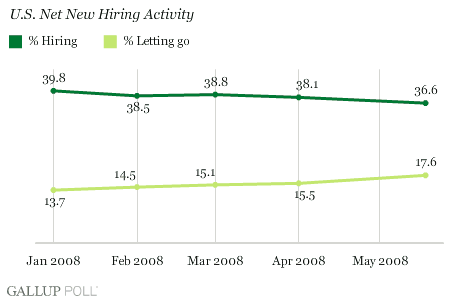
Net New Hiring Activity by Region
On a regional basis, the East has suffered the most from the recent financial crisis, with many financial services firms announcing layoffs. The 4.8 percentage-point decline in net new hiring activity between January and April reflects the significant impact on employment that has taken place. In fact, the added 2.2-point decline for mid-May suggests that while the credit markets may be stabilizing, the fallout from the credit crisis on employment is continuing.
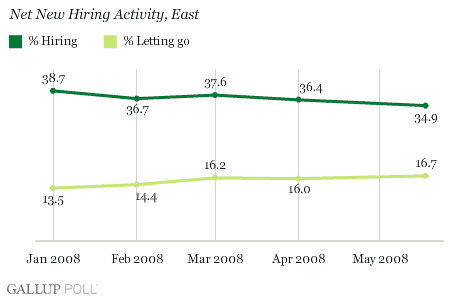
Net new hiring activity in the Midwest has fluctuated somewhat more than in other regions. Between January and February, net new hiring activity fell by 4.4 percentage points, reflecting the continued job stress in this region of the country. Job activity seemed to stabilize and even improve in April, perhaps in response to increasing export activity, but has fallen to its lowest level of the year in mid-May. The May decline seems consistent with a lagging response to the larger-than-expected 0.7% drop in industrial production in April announced by the Federal Reserve Board last week.
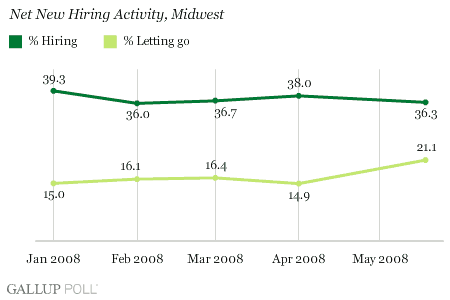
Net new hiring activity has fallen steadily in the South; this trend has continued in April. May results show a much bigger drop of 8.3 points in net new hiring activity -- this is something that will need to be watched for further confirmation in the next few months.
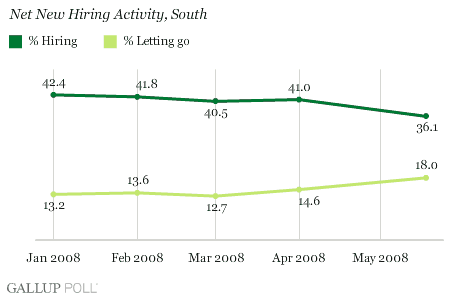
Net new hiring activity in the West had fallen between January and March, although more moderately than in the other regions of the country. In April, job-market activity seemed to drop sharply, but May results actually show an improvement that more than offset the April decline as opposed to confirming it. Given these fluctuations, future results will need to clarify the actual trend in job activity in the West.
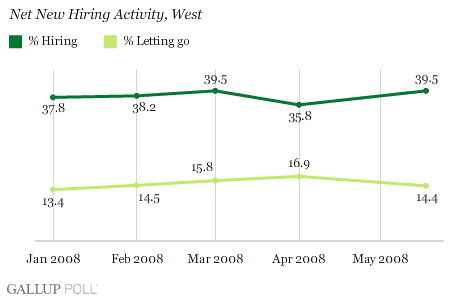
Jobs Losses Will Add to Consumer Woes
On Monday, the National Association for Business Economics reported that 56% of the economists surveyed say the United States is in or will have a recession this year, suggesting they are that the current economic downturn has reached recessionary levels. The survey also suggested that the U.S. economy will be out of recession by September, with growth picking up to 2.1% in the second half of this year.
While employment measures tend to be trailing economic indicators, reflecting past levels of economic performance, ║┌┴¤═°'s Net New Hiring Activity measure suggests that of the current economic downturn in terms of the job market. In fact, the mid-May results may mean the job losses associated with slowing economic activity may simply be lagging behind as opposed to structurally different from those of the past. Further, ║┌┴¤═°'s Net New Hiring Activity measure is not seasonally adjusted, so the decline in job market activity it reflects may actually be more severe than when seasonal hiring needs are taken into account.
Right now, ║┌┴¤═°'s reflect the fact that the consumer faces numerous significant economic headwinds, ranging from surging food and energy prices to falling real estate values and tightening credit-market conditions. Add a significant decline in May job growth as suggested by ║┌┴¤═°'s Net New Hiring Activity measure and even today's reduced expectations for consumer spending in the months ahead may turn out to be optimistic.
Survey Methods
║┌┴¤═° is interviewing no fewer than 1,000 U.S. adults nationwide each day during 2008. The economic questions analyzed in this report are asked of a random half-sample of respondents each day. The results reported here are based on combined data of more than 8,000 interviews each in January, February, March, and April 2008. For results based on these samples, the maximum margin of sampling error is ┬▒1 percentage point.
Results based on the sample of 2,136 national adults for the week of May 12-18, 2008, have a maximum margin of error of ┬▒2 percentage points.
Margins of error for the regional breaks are higher.
Interviews are conducted with respondents on land-line telephones (for respondents with a land-line telephone) and cellular phones (for respondents who are cell-phone only).
In addition to sampling error, question wording and practical difficulties in conducting surveys can introduce error or bias into the findings of public opinion polls.
To provide feedback or suggestions about how to improve ║┌┴¤═°.com, please e-mail feedback@gallup.com.
